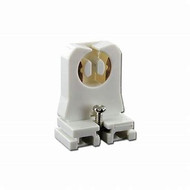Shunted Fluorescent Sockets Verses Non Shunted Fluorescent Socket, Why Should I Care?
Posted by Jesse Willoughby, President Lighting Solutions on Jul 13th 2020
Shunted Verses Non-Shunted Sockets
Most linear fluorescent light fixtures come from the manufacturer with either shunted or non-shunted sockets (tombstones) installed in them. Shunted sockets are normally installed in fluorescent fixtures containing magnetic ballast (discontinued), rapid start ballasts, and fixtures made for T12 fluorescent tubes. Non-shunted sockets usually are contained in fluorescent fixtures containing instant start ballast, dimming ballast, program start ballast, pre-heat ballast, and trigger start ballast. The label on the ballast will normally indicate which type of ballast it is. The shunted verses non-shunted issue becomes a factor when replacing an existing socket in a fluorescent fixture or when converting a linear fluorescent fixture to LED tubes.
When retro-fitting linear fluorescent fixtures with linear LED tubes, replacing the sockets may be required. The need to replace sockets will be determined by the instructions included with the LED tubes being installed. Not all retro-fits require new sockets, this is particularly true with LED tubes that are compatible with electronic fluorescent ballast. Again, check the instructions that came with your tubes.

How do I determine if the socket is shunted or non shunted. The first clue is how many holes for wire insertion the socket has. Normally, shunted sockets have two holes and accept two wires, non-shunted sockets accept a maximum of four wires and have four holes.
To ensure you have the correct socket, best practices require that a voltage meter set to continuity. If the two continuity meter probes are placed on the contacts in the socket (see picture) and the meter indicates positive continuity, the socket is shunted. If the meter does not indicate continuity by a beep or a visual indicator, then the socket is non-shunted.
This determination is important because using the incorrect socket can damage your LED tubes.

